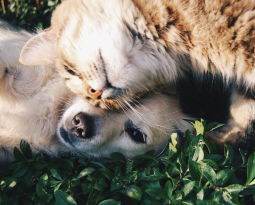That awful sound, it can wake even the hardest sleepers, from the deepest slumber. You leap from the bed to find Fido hunched over, mouth wide and a mess being made on the floor. The contents and consistency range widely and depending on what you see, the cause can range from not a problem to an emergency vet visit. If your dog vomiting is a regular event, or you just want to be prepared for when it inevitably happens (trust us, it will!) read on. We will cover the most common causes, the meaning behind different consistency in dog throw up, and what to do next.
Why Does My Dog Throw Up?
There are a huge number of reasons your dog may be throwing up. First it would be important to differentiate between vomiting and regurgitating. Vomiting has some signs of nausea before-hand like drooling, licking, and/or swallowing. Vomiting will include heaving as the pet’s abdominal wall contracts and expands to expel the food. Regurgitation, meanwhile, is a more passive process, as undigested food comes out with little effort.
For dogs, vomiting is a necessary defense for creatures who tend to eat just about anything. Whether it is digging for spoiled food, or finding some trash to munch on, vomiting is the way for the dog’s body to correct past mistakes. Sometimes the cause of the throw up is as simple as motion sickness. Sometimes, it is something worse.
Diseases That May Cause Vomiting
- Food allergies or intolerance
- Side effects
- Parasites
- Exposure to toxins
- Obstructions in the intestinal (foreign material, organs, tumors)
- Some cancers
- Diabetes
- Head trauma
- And more…
As mentioned, dog throw up has various appearances depending on their cause. Foamy vomit that is yellow is a simple, it means your dog has an empty stomach, that yellow color is from bile. If its bright green maybe that may be a sign of eating something poisonous.
The Dog Threw Up, Now What?
If the dog has only thrown up once or twice and seems to be doing fairly well, you can take the following steps for treating them at home.
First, remove any source of water and food, for six to eight hours. If they no longer vomit, gradually reintroduce water, starting with a small amount. After another 12 hours of being able to drink water with still not vomiting, it is time to offer a small, bland meal. Think white rice, boiled chicken meat. Again, if your dog takes it well and without further vomiting you can increase the amount of meal and begin mixing in their standard dog food. If over the course of this process (about 3 days) your dog begins to vomit again, seek vet attention.
If the vomiting is more than once or twice, or any of the following symptoms, call or seek out vet attention immediately.
- Anything abnormal in the vomit, things like blood, foreign objects, etc.
- Diarrhea – the combo of diarrhea and vomiting can cause dehydration
- Depression, lethargy
- Projectile vomiting
- Attempted vomiting producing nothing.
- Vomiting in puppies – puppies can’t withstand the toll of vomiting like adults’ dogs can. Any sort of vomiting in a puppy should be taken to a vet.
If any of these factors are at play with your dog, call your vet right away! If you’re in the Tucson area, gives us a call.
How to Prevent Dog Throw Up
- Don’t give your dog bones. Bones are liable to splinter and break into sharp shards
- Don’t give your dog any toys that can be swallowed or chewed up and broken down. The swallowing of these can obstruct the digestive tract.
- Don’t change your dog’s diet suddenly. Making gradual changes to your dog’s diet is a safer approach.
- Don’t let your dog eat trash. Scavenging for food in garbage can lead to eating foreign objects or toxic items.
- Cut back on the scraps. Many foods that are perfect for us are dangerous to our furry friends. If your dog has a sensitive stomach, even the dog-safe scraps can cause vomiting.
Again, if you are having any troubles with your dog vomiting, don’t hesitate to reach out to your vet, and while the occasional throw up isn’t the end of the world. Frequent vomiting however is something to take quick action with. Follow these directions, keep a watchful eye on your pups habits, and you’ll be clued in quickly whether or not it is a simple case of ate too fast or something more serious.





